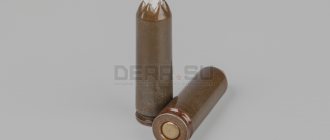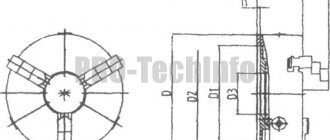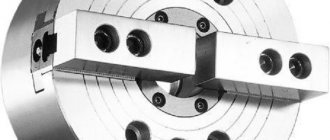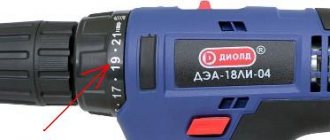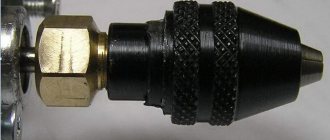Select the one you need
Mounting cartridges of the bulletless type fire according to the same principle - when the striker of the pistol strikes the primer, the impact composition located in the cartridge is ignited sequentially. The explosion energy of the gunpowder released in this case accelerates the piston of the mounting gun to values that provide the dowel-nail with the necessary speed of penetration into the material.
Read also: How to do evening makeup correctly
There are five conventional gradations in power, which is released when the mounting cartridge is triggered:
Weak. Color marking of the cartridge tip is white/gray, conventional cartridge number 1, approximate impact energy, J: for the D1 series cartridge - 680, for the K1 series cartridge - 550. Average. The color marking of the cartridge tip is yellow, the conventional cartridge number is 2, the approximate impact energy, J: for the D2 series cartridge - 820, for the K2 series cartridge - 600. Strong. The color marking of the cartridge tip is blue, the conventional cartridge number is 3, the approximate impact energy, J: for the D3 series cartridge - 960, for the K3 series cartridge - 680. Extra strong. The color marking of the cartridge tip is red, the conventional cartridge number is 4, the approximate impact energy, J: for the D4 series cartridge - 1090, for the K4 series cartridge - 740. Particularly strong. The color marking of the cartridge tip is black, the conventional cartridge number is 5, the approximate impact energy, J: for the D5 series cartridge - 1300, for the K5 series cartridge - 920.
What data can be obtained from the labeling?
Mainly:
- Service marks. As a rule, this is a marking on the bottom of the cartridge. It allows you to find out about the place of manufacture (country, enterprise), type (name) and caliber. The time of creation, material, purpose, model and type of weapon for which it is intended can also be placed.
- Coloring of elements. Can be applied to bullets, primers, and these parts of cartridge cases. Talks about the type of cartridge, some features of its design or purpose.
- Labels. They contain the same data as on the stamps. In addition, there may be certain information about the elements of cartridges, ballistic characteristics, etc. Often, due to the need for a large area to communicate all the necessary information, they are applied to wooden boxes, moisture-proof bags, cardboard boxes, paper bags, metal boxes.
The marks left are symbols, which are presented in the form of numbers, pictures and letters embossed on the surface of the cartridges. They can be service or control. The first allows you to obtain data about the manufacturer, production date, time of creation, certain design features, purpose and some other information characteristic of a certain period of time or inherent in a particular country in general.
Labeling of factory products
Professional electricians are not content with one size and a quick visual inspection of the product; they carefully read the markings printed in indelible ink or embossed on the visible part of the socket.
Typically, the labeling includes technical characteristics or conditions of use that are of fundamental importance when choosing light sources
The most responsible manufacturers apply the markings and attach short manuals to the products listing important characteristics.
The list of parameters that can be found on the cartridge is not always complete.
Usually any of the following characteristics are reflected:
- type, for example, threaded, pin;
- size;
- temperature;
- load current;
- power;
- voltage;
- manufacturer's trademark;
- level of protection;
- presence of contact for grounding.
Before purchasing cartridges, study the manufacturer’s website, where detailed technical information and a diagram with dimensions are usually posted.
In addition to reviewing the technical characteristics and conditions of use of the product, it is necessary to clarify exactly how the cartridge is attached and what holes/latches are provided for fixing
When choosing, it is also worth considering that ceramics are stronger than plastic and can withstand higher temperatures. If the cost of a product is questionably low, there is a chance that it is a fake.
It’s better to play it safe and buy a more expensive, but high-quality electric cartridge from a reputable brand.
Characteristics
A user who frequently uses a drill should know and understand the sizes of chucks that are on the market. In addition to the difference in shank diameter, some require the purchase of a separate adapter or adapter.
By the maximum diameter of the shank you can understand how widely the clamping blades diverge.
In this case it is:
Kinds
There are several types of collet chucks with jaws inside:
- quick-release;
- key (gear-crown);
- mini-cartridges.
Quick-clamping ones are used without an additional key, which is their main advantage. The user has the opportunity to replace the cartridge quickly and without additional tools. Clamping is done automatically, which allows you to significantly reduce the time for changing attachments.
One of the disadvantages of the clamping chuck is instability during prolonged use. Over time, the mechanism becomes loose and can no longer provide the required level of fastening, as a result of which the round shanks rotate.
More experienced craftsmen prefer key chucks because they are more reliable and have to be tightened by hand. However, during operation it is easy to lose the key.
Mini-chucks that are installed on a small drill or drilling machine are no less in demand today. Most often, jewelers use small cartridges.
These main types have subtypes:
- self-clamping;
- turning;
- angular;
- with Morse taper;
- with ratchet.
According to the type of fastening, the cartridge can be:
- conical;
- threaded
The self-clamping, like the quick-clamping, has its advantages: you don’t need a key to use it. Unlike the second, where the clamping occurs automatically, with a self-clamping chuck you need to use your hand. The user pushes the element towards himself with his hand, thereby loosening the fastening, and the nozzle can be removed. This position is held until another drill is placed, then it is released, and the chuck again fixes the nozzle, holding it tightly. In the design, the role of a coupling is played by a blocker.
The conical cartridge is put on without using a thread; accordingly, the threaded one is screwed onto the rod. This is their main difference.
The lathe chuck can be manual three- or four-jaw, as well as mechanical two- or three-jaw. Some models are self-centering. They are installed on the front flange of the spindle or on the adapter flange.
Angular is used when it is necessary to make a hole at an angle of exactly 90 degrees or in a hard-to-reach place. It looks like a specialized attachment with a key cartridge in the design.
The Morse taper element is used for equipment with appropriate mounting. The equipment must comply with GOST requirements. The main purpose is to reduce the radial runout of the drill and the distance at which the drill is fixed in the chuck. It is a mandatory requirement that the dimensions of the cone on the equipment and inside the cartridge match.
Few users know what a ratchet chuck is and what its peculiarity is. The ratchet in the design is used to adjust the torque. It is thanks to it that the user is able to adjust the depth to which the drill enters or the screw is screwed in, which is very important when working with drywall, when you can easily pass the screw through.
To learn about the types of drill cartridges, see the following video.
Tool for driving construction cartridges
Construction chucks are used for direct installation. Special mounting guns of various brands and designs are produced for construction cartridges.
The explosive mixture is held inside the cartridge case by a wad, which is made of porous compressed gunpowder. The powder is smokeless and does not contain heavy metals (lead, antimony or mercury). The cartridges can be used for pistol mounting indoors.
«>
Mounting guns (PMT-1 and PC-84) are classified as powder tools. They are specially designed for driving fastening building structures to brick and concrete foundations using direct shooting with construction cartridges and dowel-nails. Using mounting guns, it is easy to obtain permanent fastenings by direct shooting to a concrete or brick surface. You cannot use construction cartridges in firearms!
A simple homemade pistol chambered for a construction cartridge
Types of pistols
Although there are several types of such tools (gas, pneumatic and powder), the mounting cartridge is used only in the latter. Structurally, it is close to firearms and works on a similar principle, therefore, it is mainly produced in weapons factories. Accordingly, the quality is confirmed by well-known world brands - TOZ, Walter, Spit, Remington, Hilti and others.
Read also: Construction lime for concrete
Pistols are also divided according to the type of cartridge feeding into: single-shot (manual feeding), semi-automatic (cassette-disc) and automatic (cassette). The latter are characterized by the highest productivity, which can make about 700 connections in an hour.
To perform specific tasks, for example, for roofing work on metal structures, installing corrugated sheets or waterproofing tunnels, working with concrete, low-carbon steel, fastening metal gratings, special gun designs are produced.
The mounting cartridge used in such pistols is blank. However, safety precautions must always be observed when working with this tool. The device itself is disassembled, inspected, cleaned and lubricated approximately every five hundred shots.
Characteristics and types of mounting chucks
Before using the tool, you need to learn what types of cartridges there are. They are classified according to the following criteria:
- By marking. It is made in different colors at the end and determines the power parameters.
- In size - long and short.
- Diameter – 5.6*16, 6.8*11, 6.8*18 mm.
- By number, which indicates the weight of the gunpowder.
- According to the shape of the packaging - for multi-chargers and machine guns, consumables are produced in a strip.
The specific color of the marking indicates, depending on the series, the specific power in J:
- White or gray - low power, 550 - 680.
- Yellow – medium, 600 – 820.
- Blue – strong, 680 – 960.
- Red – super strong, 740 – 1090.
- Black – especially strong, 920 – 1300.
Reinforced types of consumables have high power and are used in industry as an element of stamping equipment.
Classification
Since a mismatch in the capabilities of the mounting cartridge can cause damage to the powder pistol, the classification of these consumables is carried out simultaneously according to several parameters:
Read also: Instructions for the OZONE card
- By color. It determines the charge power in joules, and the marking itself is made on the conical tip of the cartridge.
- In height and diameter. There are long (D) and short (K) cartridges. The mounting tool uses 5.6×16, 6.8×11 and 6.8×18 mm cartridges.
- By cartridge number, which determines the mass of the powder charge.
- According to the packaging method. For example, for repeating or automatic pistols, cartridges are supplied only in a belt.
All types of mounting chucks used in construction work have a standard design and consist of the following parts:
- A steel casing containing a charge of smokeless powder. In K series cartridges, gunpowder fills the entire space of the cartridge case, and in D series cartridges - only its bottom part;
- Capsule;
- A wad made of pressed gunpowder that holds the percussion compound in the cartridge case;
- Crimping of the sleeve from above with corresponding markings by color.
Materials and technical requirements for the production of mounting cartridges are regulated by the requirements of TU 3 -795-94.
Characteristics of cartridges
There are quite a few modifications of cartridges for direct mounting. For ease of selection, additional markings are provided.
The construction chuck is precisely selected for specific work:
1. D 1 (marking color white) - made from environmentally friendly materials, does not contain heavy metals, and is used in enclosed spaces.
2. D 2 (yellow color) - used for fastening steel building structures with a thickness of 2 to 4 mm in a stone or concrete base.
3. D 3 (blue color) - used for fastening steel, aluminum or wooden structures to a concrete base.
4. D 4 (red color) - considered the most powerful, used for fastening building elements on surfaces made of concrete, brick and low-carbon steel, has an energy output of 700 J.
5. K 1 (white) – energy output 548 J, charge 0.2 g.
6. K 2 (yellow) – energy output 603 J, charge 0.22 g.
7. K 3 (blue) – energy output 683 J, charge 0.25 g.
Suddenly a cartridge was found
For most people, getting their hands on ammunition is not an easy task. And those who do have access to them usually also have professional training: police officers, athletes, hunters, game wardens, military personnel. Therefore, a situation where there is a supply, but it cannot be classified, is unlikely for them. After all, they basically give out what is already well known.
But there have been numerous military conflicts on our territory. From many you can only find rusty iron and nothing more. But the Great Patriotic War has left its mark to this day. And finding bullets from that period is not a problem now. Of course, according to current legislation, the police must be informed about them and handed over to the sappers who arrive. But it’s interesting - what was found?
If we talk about the markings of World War II cartridges used by the Soviet Union, then first of all it is necessary to note 7.62x54. The 1891 model was blunt-pointed, while in 1908 a pointed one was introduced. That is, they can be distinguished by shape. In addition, you can also find a 7.62x25 TT cartridge. This sample was also used in such legendary weapons as PPSh, PPD, PPS. Tracer bullets are separately marked in green.
But not only domestic representatives come across. The markings of German cartridges from the Second World War may also be relevant. For example, 7.92x57. Their sleeves are distinguished by brass, bimetallic or steel varnishing. Moreover, there are both blunt-pointed and pointed ones.
Other bullets can be found on the territory of the Soviet Union, although problematic. These are mainly visitors and perform an auxiliary role. But if you move to other fronts, you will find different cartridges from the Second World War. The marking of French 8x50R bullets is distinguished by an annular groove at the bottom
Importantly, it is the first French smokeless rifle cartridge, developed in 1886. But the most relevant is still the marking of German cartridges of the Second World War, as well as Soviet models
Especially many of them can be found in places of major battles.
Mounting cartridge: principle of operation
The principle of operation of all mounting guns is the same, only in powder guns the dowel is clogged with a piston, which is activated by the force of the explosion of the cartridge. The force on the dowel is selected in accordance with the density of the base into which it is driven. It can be adjusted either by choosing the power of the cartridge, or mechanically, if this is provided for by the design of the pistol.
A bulletless (blank) mounting cartridge has the form of a sleeve, the open end of which is rolled and is marked with color markings corresponding to the power. It is usually loaded with smokeless powder. Ignition and explosion occur after the firing pin hits the igniter primer.
In some cases, there are also mounting cartridge designs equipped with a Berdan and Boxer type primer (used in military projectiles).
Powder guns cannot be used for installation work involving materials such as glass, ceramics, cast iron, curbstone and granite.
How to do it and what is needed for the work?
In order to create such a device, you will need the following elements:
- excavator oil pipe;
- mainspring, which works with the car's cable;
- shutter (it can be made from an ordinary shutter);
- trigger, which can be a nail;
- lever;
- frame.
A homemade pistol is convenient because it is easy to make with your own hands. In addition, such a device does not require specialized equipment. During operation, this pistol model has the ability to automatically get rid of the used cartridge case, as the powder gases are released, and this, in turn, facilitates the reloading itself. The recoil softening process occurs due to the tensioning mainspring, which absorbs it.
The sequence of loading a construction gun: a – putting on the tip, b – opening the gun, c – pushing out the wad, d – inserting the dowel into the barrel bore, e – inserting the cartridge, c – closing the gun.
So, the process of creating a homemade pistol is as follows:
- To make the handle, you will need a little carpentry skill. A birch block is suitable for it. The handle is made individually to suit your needs and desired dimensions.
- After the handle is ready, it is attached to the frame with self-tapping screws. On the back of the nail, a corner is made, for which it is bent.
- Next, you need a pipe with a diameter exceeding the barrel by 1-1.5 cm. The bolt frame will be made from it. At a short distance from the end, a transverse cut of 3-4 cm is made. This place will be intended for throwing out the empty cartridge case and charging the mounting cartridge itself. The handle on the shutter should point to the side, otherwise it will interfere with looking through the sight.
- Near the firing pin, when the bolt is cocked, it is necessary to make a hole on the bottom side for the trigger. In order for the mainspring to hold, you need to drill a couple of holes at the end of the tube. And at the beginning of this element it is necessary to make a cut that will fix the trunk.
- Next comes the insertion of the barrel, after which it is securely clamped with two rings and bolts. By the way, one of the rings will serve as a sight.
Conclusions and useful video on the topic
Installation of different lighting devices may differ, so we present several video instructions for connection.
Connecting ceramic and carbolite cartridge:
Option for connecting wires to a plastic socket:
Replacing the G4 chuck:
The cartridges are designed quite simply, so you can disassemble, replace or repair home electrical installations yourself.
The most important thing is to turn off the mains voltage if you are working with a lighting device, and strictly follow the recommendations of experienced electricians. When installing a new model, you must follow the manufacturer's instructions.
Do you have anything to add or have questions about choosing and replacing a light bulb socket? You can leave comments on the publication, participate in discussions and share your own experience. The contact form is located in the lower block.
Legislative status
According to the Resolution of the Plenum of the Supreme Court of the Russian Federation No. 5 of March 12, 2002 “On judicial practice in cases of theft, extortion and illegal trafficking of weapons, ammunition, explosives and explosive devices”,
...construction and installation pistols and revolvers... do not belong to weapons, liability for illegal actions with which is provided for in Articles 222-226 of the Criminal Code of the Russian Federation
...construction... and other cartridges that do not have a striking element (projectile, bullet, shot, buckshot, etc.) and are not intended to hit a target, do not belong to ammunition, explosives and explosive devices
Mounting cartridges for powder tools, according to the degree of danger according to GOST 19433-81, belong to class 4, subclass 4.1 - flammable solids.
What comes first - the weapon or the cartridge?
As a rule, when assessing the effectiveness of a particular type of small arms, we talk about weapons. The cartridges are perceived as something like “batteries” - the weapon does not fire without them, but, by and large, they do not affect anything (well, unless they differ in type: explosive, armor-piercing, etc.). However, this is completely the wrong approach!
Ammo feed, rate of fire, stability - all this really concerns the weapon itself. But the initial speed of the bullet, its mass, armor penetration, stopping effect - this already depends on the cartridge.
The cartridge is the base! Tell me what cartridge and I will tell you most of the other characteristics of the weapon. There is nothing mystical here - the weapon is made for a cartridge, not cartridges for a weapon. If the designer provides for the acceleration of a bullet over a barrel length of approximately 70 calibers, then this is a rifle cartridge. 40-50 - transitional cartridge for carbines, etc. In other words, it is the cartridge that determines what the weapon will be: a pistol, rifle or carbine. Accordingly, the adoption of a new cartridge by a state shapes the military-production policy of this state for many years to come.
For example, the 7.62x39-mm cartridge of the 1943 model was put into service back in 1949, and is still used not only in such well-deserved models as the SKS or AK, but also in the relatively recent AK-103 and AK-104, or Saiga and Vepr carbines. In fact, the characteristics of all these small arms (and all others designed for this cartridge, even those that may yet appear in the future!) were predetermined back in 1949.
